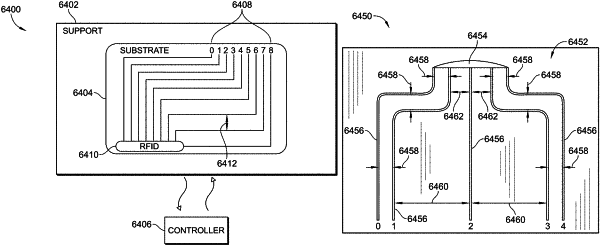| CPC A61F 13/42 (2013.01) [A61B 5/207 (2013.01); A61B 5/6802 (2013.01); A61B 5/6804 (2013.01); A61B 5/6808 (2013.01); A61B 5/6892 (2013.01); A61B 5/7465 (2013.01); A61G 7/015 (2013.01); A61G 7/05 (2013.01); G06K 7/10069 (2013.01); G06K 7/10168 (2013.01); G06K 7/10356 (2013.01); G06K 7/10366 (2013.01); G16H 40/20 (2018.01); H01Q 1/2216 (2013.01); H01Q 9/0407 (2013.01); H01Q 9/0457 (2013.01); A61B 5/0022 (2013.01); A61B 5/05 (2013.01); A61B 5/202 (2013.01); A61B 2503/08 (2013.01); A61B 2560/0468 (2013.01); A61B 2562/164 (2013.01); A61F 2013/424 (2013.01); A61G 2203/30 (2013.01); A61G 2203/70 (2013.01); A61G 2205/60 (2013.01); G01M 3/045 (2013.01); G06K 7/0095 (2013.01); G06K 19/07718 (2013.01); G08B 21/20 (2013.01); Y10T 156/1052 (2015.01); Y10T 156/1056 (2015.01)] | 20 Claims |

|
1. An incontinence detection system for use with a patient support apparatus having a head end and a foot end, the incontinence detection system comprising
an incontinence detection pad having a passive radio frequency identification (RFID) tag,
a reader attachable to the patient support apparatus and operable to read data from the passive RFID tag,
a first antenna attachable to the patient support apparatus,
a second antenna housed separately from the first antenna and attachable to the patient support apparatus at a location spaced from the first antenna, wherein the first and second antenna are electrically coupled to the reader, wherein the passive RFID tag is excited by energy emitted from at least one of the first and second antennae and the data from the RFID tag of the incontinence pad is reflected back to at least one of the first and second antennae,
a visual indicator electrically coupled to the reader by a first cable having sufficient length to permit the visual indicator to be mounted adjacent the foot end of the patient support apparatus, and
an output port electrically coupled to the reader by a second cable having sufficient length to permit the output port to be mounted adjacent the head end of the patient support apparatus.
|